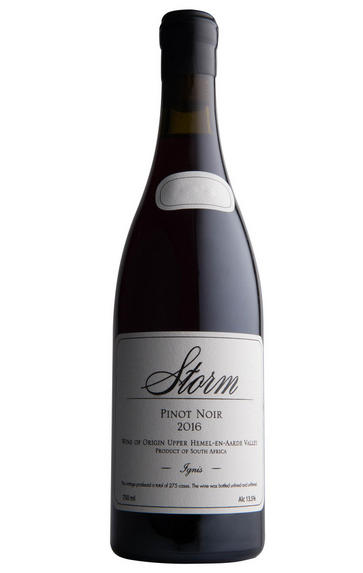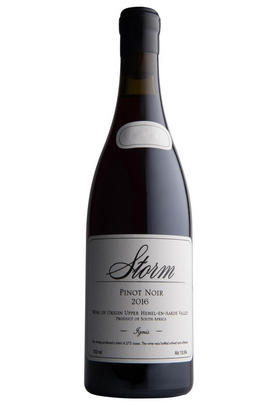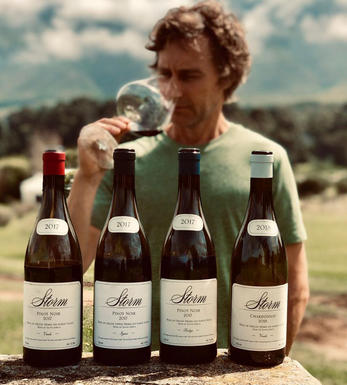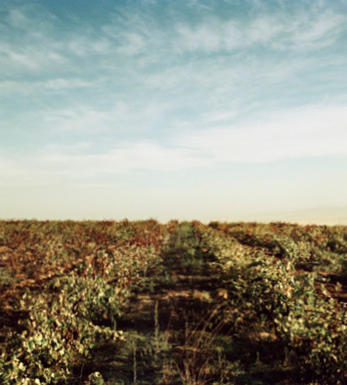
2018 Storm, Ignis, Pinot Noir, Hemel-en-Aarde Valley, South Africa

About this WINE

Storm Wines
Winemaker Hannes Storm worked 12 vintages in the Hemel-en-Aarde Valley before he discovered two parcels of land with exceptional terroir and embarked on his eponymous project, Storm Wines. His aspiration is clear: to create wines with a sense of place. His natural approach and careful viticulture produce classically proportioned wines with distinctive personality and an innate purity.
Storm focuses on Pinot Noir and Chardonnay. Located in the Hemel-en-Aarde Valley and Upper Hemel-en-Aarde Valley, their three vineyard sites – Ignis, Vrede and Ridge – each possess an individual character. Storm Wines is now the only producer with Pinot Noirs from each of the three appellations in the Hemel-en-Aarde.
The Ignis vineyard is located on a northern slope in the Upper Hemel-en-Aarde Valley. The vineyard is cluttered with round pebbles on the soil surface with underlying decomposed granite. The Ridge and Vrede sites both rest on a cool, eastern slope in the Hemel-en-Aarde Ridge, with low-vigour, stony, clay-rich Bokkeveld shale soils and a cool Atlantic Ocean influence, producing wines with high natural acidity and cool minerality.

South Africa
It has taken the majority of the last two decades for the South African wine trade to become the truly exciting place it is today. First of all, it wasn’t only apartheid that held the Cape’s most talented winemakers back, it was also the dominance of the state-controlled winemaking cooperative, the Koöperatieve Wijnbouwers Vereniging van Suid-Afrik (KWV). The KWV brought stability to many South African growers but its prices were based on quantity rather than quality. This encouraged the bulk production of inexpensive, inferior wines that did nothing to establish the region’s potential to impress at a higher level in virgin export markets. South Africa quickly gained a reputation for cheap and cheerful wines that lacked substance and often had a smoky character, which many experts attributed to virus-ridden vines.
It was following the privatisation of the KWV in 1997 that the South African wine industry really began to open up. Winemakers who had been frustrated by the cooperative’s restrictions were suddenly free to reduce yields and focus on producing smaller volumes of higher-quality wines; however, Rome wasn’t built in a day. It took some time for many of the larger wineries to appreciate that investment in the vineyards, and wineries could yield longer-term profits. A number of enthusiastic mavericks left their previous roles in larger corporates and took the risky strategy of setting up on their own; mavericks such as Eben Sadie, who was integral not only to establishing the Swartland as a new, cult Cape wine region but whose efforts have firmly planted South Africa on the global fine wine map.
Where Eben led, others followed, and in the mid- to late 2000s, high-quality winemaking became a key focus among the estates of the Western Cape. Historic properties such as Oldenburg in Stellenbosch which had old, disused vineyards were suddenly brought back to life by their new owners, and vast tracts of land were replanted on carefully chosen, virus-free rootstocks. Adrian Vanderspuy took over Oldenburg Vineyards in 2003 and immediately replanted the entire estate with new vines. Constantia Glen transformed its beautiful spot near Cape Town and also focused entirely on regenerating the vineyards; but vines take at least three years to grow to the point of producing quality wine, and so time passed. Both estates’ first vintage was in 2007.
Even more exciting for the South African vinous scene today are the young winemakers who have travelled the world to gain inspiration, and have since come home to establish their own unique projects. Not wanting simply to follow the Bordeaux model so assiduously created in Stellenbosch, Chris and Andrea Mullineux produce glorious Rhône-inspired reds and whites in Swartland, which are now widely acknowledged to be some of the best wines in the Western Cape. In short, much has changed since 1992, but South Africa’s winds are firmly blowing in the right direction with superb results now, and even more promise for the future.
Nature is certainly on South African wine producers' side, with plenty of sunshine in this warm Mediterranean climate, yet tempered by oceanic, onshore breezes. Climate plays a greater role in determining the style and quality of the Cape's wine, while the predominantly granitic (ie low pH) soils contribute to a generally fuller, rounder, low-acid mouthfeel.
Stellenbosch with 17,500 ha is the most important fine wine producing district, followed by Swartland with 15,000 ha and then Paarl at 18,000 ha. Worcester (20,500 ha), Robertson (13,500 ha), Olifants River (10,000 ha) and Orange River (5,000 ha) make up the difference.
Newly-created wine regions include the coastal Elgin (near Cape Agulhas, Africa's southern-most tip), West Coast, Langloof, and Prince Albert (near the majestic Swartberg mountains).
The split of white to red wine production was 55:45 in 2005. The white wine grapes are dominated by Chenin Blanc (Steen) with 20 percent share, with Sauvignon Blanc and Viognier the great white hopes. The red wine grapes are led by Cabernet Sauvignon with 13 percent, with Merlot and Shiraz close behind.
Pinotage, South Africa's indigenous grape varietal (a cross between Pinot Noir & Cinsaut -spelt “Cinsault” in the Southern Rhône) and its plantings are decreasing.

Pinot Noir
Pinot Noir is probably the most frustrating, and at times infuriating, wine grape in the world. However when it is successful, it can produce some of the most sublime wines known to man. This thin-skinned grape which grows in small, tight bunches performs well on well-drained, deepish limestone based subsoils as are found on Burgundy's Côte d'Or.
Pinot Noir is more susceptible than other varieties to over cropping - concentration and varietal character disappear rapidly if yields are excessive and yields as little as 25hl/ha are the norm for some climats of the Côte d`Or.
Because of the thinness of the skins, Pinot Noir wines are lighter in colour, body and tannins. However the best wines have grip, complexity and an intensity of fruit seldom found in wine from other grapes. Young Pinot Noir can smell almost sweet, redolent with freshly crushed raspberries, cherries and redcurrants. When mature, the best wines develop a sensuous, silky mouth feel with the fruit flavours deepening and gamey "sous-bois" nuances emerging.
The best examples are still found in Burgundy, although Pinot Noir`s key role in Champagne should not be forgotten. It is grown throughout the world with notable success in the Carneros and Russian River Valley districts of California, and the Martinborough and Central Otago regions of New Zealand.


Buying options
Add to wishlist
wine at a glance
Delivery and quality guarantee